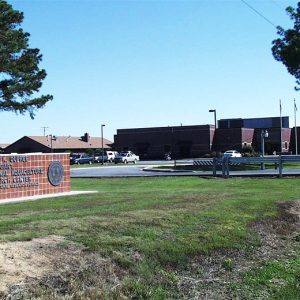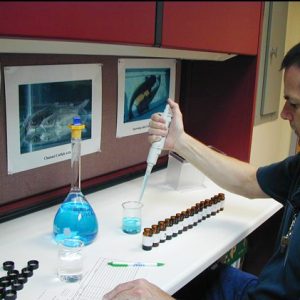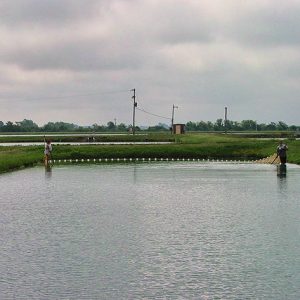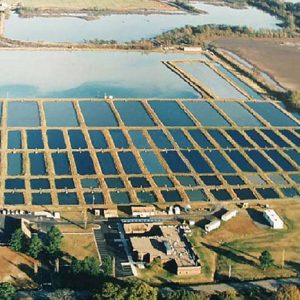calsfoundation@cals.org
Harry K. Dupree Stuttgart National Aquaculture Research Center
The U.S. Department of Agriculture Agricultural Research Service (USDA-ARS) actively supports aquaculture through research conducted at the Harry K. Dupree Stuttgart National Aquaculture Research Center (HKDSNARC) in Stuttgart (Arkansas County). The mission of the HKDSNARC is to conduct cutting-edge research that addresses the highest priorities of the U.S. aquaculture industry, as well as serving as a global leader in aquaculture research. The research conducted addresses vital issues that are national in scope and result in new knowledge that informs scientists, farmers, feed mills, pharmaceutical companies, processors, teachers, governmental agencies, and consumers. The HKDSNARC collaborates with universities, international research institutions, government agencies, and private industry.
Since the 1970s, aquaculture has been the fastest-growing sector of global food production. Global aquaculture production in 2011 totaled 66 million tons (excluding aquatic plants) valued at $119 billion. The production of foodfish from aquaculture increased at an average annual growth rate of 8.8% worldwide from 1980 to 2010 and supplies half of all seafood consumed in the world. Future growth and reliance on the culture of aquatic organisms for human consumption is projected to continue as global population and consumer demand increases, and as capture fisheries become less able to meet that demand. Arkansas has more than 10,000 acres of water devoted to fish production and is the largest producer of baitfish and the third-largest producer of channel catfish in the United States. The state is home to the world’s largest minnow producer, the world’s largest goldfish producer, and the world’s largest producer of striped bass and hybrid striped bass. Aquaculture is worth an estimated $170 million annually to Arkansas.
The USDA-ARS has conducted aquaculture research at the Stuttgart site since 1958, when Congress enacted the Fish Rice Rotation Act. This act directed the secretary of the interior (in cooperation with the USDA) to develop a program to solve problems related to production and harvest of warmwater fish. The idea was to establish a program to raise fish in flooded rice fields in rotation with the rice crop. The Fish Farming Experimental Laboratory (FFEL) was opened in 1961 and was devoted to research, extension, and fish disease diagnostics. In 1996, FFEL was transferred to the USDA-ARS and was renamed the Stuttgart National Aquaculture Research Center (SNARC). Three years later, it was renamed after long-time director Harry K. Dupree upon his retirement. The HKDSNARC employs approximately thirty people, including seven PhD-level researchers. Many of the scientists at the HKDSNARC are recognized nationally and internationally for their achievements in scientific research and development of practical applications.
Facilities at the eighty-five-acre site include an 18,000-square-foot laboratory/office building; an adjacent wet laboratory (3,700 square feet); an updated auxiliary laboratory (2,100 square feet); a mechanical shop and equipment fabrication building (1,700 square feet); a plumbing and metal fabrication building (600 square feet); a water filtration and purification plant (160 square feet); a general storage building (3,000 square feet); and a vehicle storage shed (1,800 square feet). An 8,000-square-foot wet-lab building houses approximately 200 tanks and troughs for hatching and rearing fish. In addition to buildings, the facility has thirty-six 0.1-acre ponds, thirty-six 0.25-acre ponds, nine one-acre ponds, a three-acre pond, and a twenty-seven-acre reservoir used for research activities. Water is obtained from three wells with a total capacity exceeding 1,000 gallons per minute.
Research priorities include refining nutritional requirements; evaluating alternate sources of protein for fish feeds; developing aquaculture feeds that are environmentally sustainable; designing and evaluating new production technologies that can grow more fish per unit of volume, improve water quality, and reduce water use; improving reproductive performance of fish by using molecular, cellular, and genetic sequencing techniques; developing feeds for first-feeding larval and small juvenile fish to improve growth and survival and reduce the cost of production; and investigating new compounds and techniques to treat disease, approve drugs to treat fish diseases, and evaluate human food safety.
For additional information:
“Aquaculture.” U.S. Department of Agriculture. http://www.usda.gov/wps/portal/usda/usdahome?navid=AQUACULTURE (accessed October 20, 2021).
Harry K. Dupree Stuttgart National Aquaculture Research Center. http://www.ars.usda.gov/Main/site_main.htm?modecode=62-25-10-00 (accessed October 20, 2021).
Carl Webster
Harry K. Dupree Stuttgart National Aquaculture Research Center
 Agriculture
Agriculture HKDSNARC Buildings
HKDSNARC Buildings  HKDSNARC Fish Disease Research
HKDSNARC Fish Disease Research  HKDSNARC Fish Feeding
HKDSNARC Fish Feeding  HKDSNARC Seine Fishing
HKDSNARC Seine Fishing  HKDSNARC Aerial View
HKDSNARC Aerial View 




Comments
No comments on this entry yet.